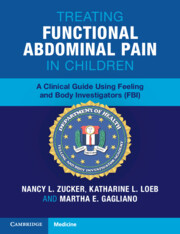 Treating Functional Abdominal Pain in Children
Treating Functional Abdominal Pain in Children Book contents
- Treating Functional Abdominal Pain in Children
- Treating Functional Abdominal Pain in Children
- Copyright page
- Dedication
- Contents
- Acknowledgements
- Part I The Background Science Behind Feeling and Body Investigators
- Chapter 1 Becoming a Feeling and Body Investigator – Pain Division
- Chapter 2 Visceral Sensitivity as a Superpower
- Chapter 3 Responsive Parenting and Creating Safety
- Chapter 4 Discriminating Safe from Threatening Body Sensations: The Science of Interoceptive Exposures
- Chapter 5 The Medical Evaluation of Abdominal Pain in Children – One General Pediatrician’s Approach
- Part II A Session-by-Session Guide to Feeling and Body Investigators
- Part III Sample Workbook Pages, Handouts, and Additional Resources for Feeling and Body Investigators
- Index
- References
Chapter 4 - Discriminating Safe from Threatening Body Sensations: The Science of Interoceptive Exposures
from Part I - The Background Science Behind Feeling and Body Investigators
Published online by Cambridge University Press: 18 November 2023
- Treating Functional Abdominal Pain in Children
- Treating Functional Abdominal Pain in Children
- Copyright page
- Dedication
- Contents
- Acknowledgements
- Part I The Background Science Behind Feeling and Body Investigators
- Chapter 1 Becoming a Feeling and Body Investigator – Pain Division
- Chapter 2 Visceral Sensitivity as a Superpower
- Chapter 3 Responsive Parenting and Creating Safety
- Chapter 4 Discriminating Safe from Threatening Body Sensations: The Science of Interoceptive Exposures
- Chapter 5 The Medical Evaluation of Abdominal Pain in Children – One General Pediatrician’s Approach
- Part II A Session-by-Session Guide to Feeling and Body Investigators
- Part III Sample Workbook Pages, Handouts, and Additional Resources for Feeling and Body Investigators
- Index
- References
Summary
This chapter provides the rationale and background of interoceptive exposure exercises, the body investigations parents and children (and possibly healthcare providers) will perform in each session. The origins of these exercises in the treatment of panic disorder will be reviewed, while introducing key developmental considerations and explaining the importance of an acceptance-based framework. In brief, in the context of panic disorder, interoceptive exposure exercises were intended to provoke a sensation that was feared and to provide new learning that this experience is not dangerous - new learning that competes with prior beliefs of harm or threat. One of the strengths of the FBI approach is that it uses sensations rather than cognitions as a framework for learning. This is essential for children who often do not have access to the content and meaning of their thoughts, or the language to articulate them with insight. As children do not have well-formed beliefs about threats, body exposure investigations are designed to help children learn how smart and trustworthy their bodies are –experiences that may directly contrast with their prior ones of weakness and vulnerability.
Keywords
- Type
- Chapter
- Information
- Treating Functional Abdominal Pain in ChildrenA Clinical Guide Using Feeling and Body Investigators (FBI), pp. 32 - 36Publisher: Cambridge University PressPrint publication year: 2023


